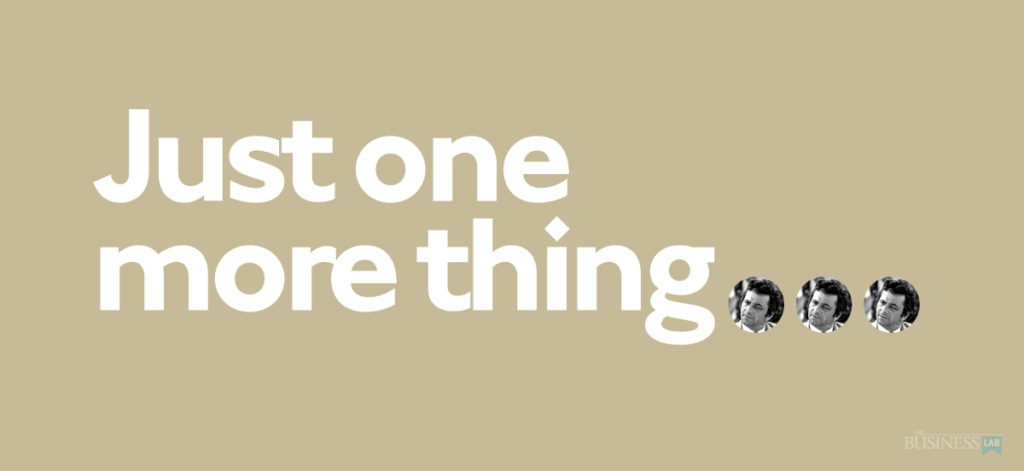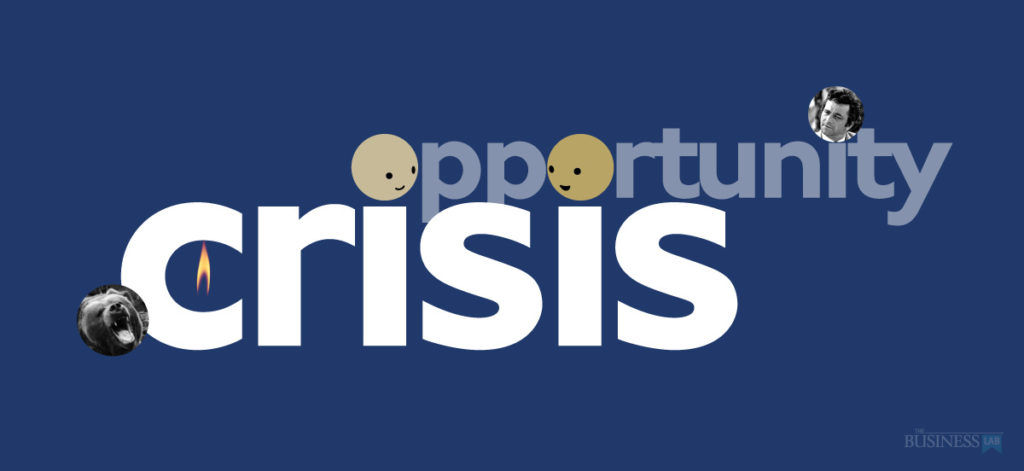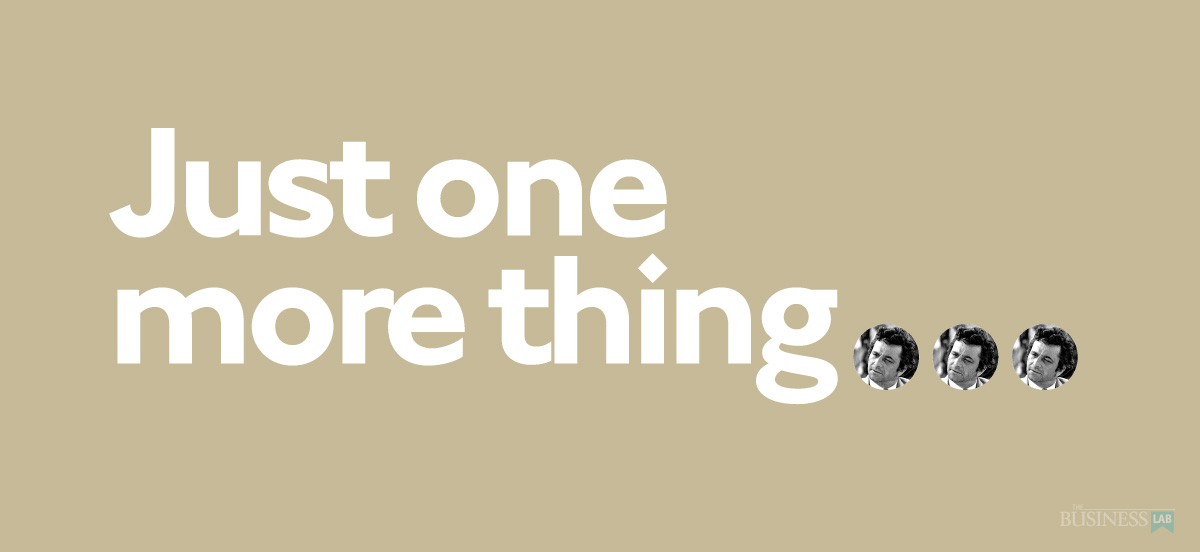Just one more thing….

Forty years ago, if you wanted to stop product shortages or missed due-dates, the solution was there. It was clear, it was fast, it was simple, and it was pure common sense. You could do it with the same people, the same machines, the same resources you currently had.
The results were staggering — some, exponential.
Things like… Within four years, net profits equal to total sales… Going from the brink of bankruptcy to shares reaching 7300% of their value within seven years… Profitability improved to four times the industry average… Lead times reduced from 40 hours to 8… Seventy-six percent increase in annual sales… In less than 18 months, market share up by 25%, sales up 23%, total supply lead times reduced 90%, new products as a percentage of sales up 50%, OSHA recordables down 86%, and millions in CAPEX deferred… Sales increase of 62%, expenses reduced 67%, net profits up 531%, and return on assets up 403%… In 12 months market share goes from 15% to 80%… On-time deliveries improve from 60% to 96%, inventory decreases by 30% while doubling sales and reducing the cost of quality from 6% to 3.5%.
…Crazy results.
And not just the Fortune 100. There were donut shops, furniture manufacturing with $3M in sales, warehousing, cabinet makers with $9.5M in sales, spring & wire companies with $12M sales. Small, medium, large — manufacturing, logistics, and projects all saw the same kind of results.
It favored no specific industry, product, or service. If a company was producing X, Y, or Z to serve their client and the market, then it worked.
Every company who used the solution had the same staggering results — a preeminent position because of their decisive competitive advantage.
What’s fascinating, and what caught our eye, was how few companies took advantage of the solution.
It wasn’t a secret. It was in plain sight.
You could buy a book for less than $10, authored by the creator, with an easy to digest and very clear do-it-yourself outline.
You could attend events for less than $1000, where companies who used the solution would tell you how they did it.
Experts trained to help companies use the solution were available and willing to work on results-based performance.
Why didn’t everyone who knew about it take advantage?
Was it inertia that grew out of a commitment to what they knew? Was it fear of risk? Was it disbelief? Was it, ‘yeah, but we’re different’?
Was it leadership okay with being just a little better than the competition — relying on the existing benchmark to judge their performance?
Turns out, there were two kinds of leaders who used the solution.
- The true, competition-leapfrogging, order-of-magnitude-seeking visionary leader who believed that significantly better performance was possible. And they believed it wouldn’t take a herculean effort. They had a simple but profound belief that more, a lot more, was doable.
“And the minute that you understand, you can poke at life, and if you push in, something will pop out the other side, that you can change it, you can mold it. That’s maybe the most important thing. To shake off this erroneous notion that life is there and you’re just gonna live in it, vs. embrace it, change it, prove it, make your mark upon it.” — Steve Jobs
- The visionary leader with their back against the wall. Things weren’t going well….at all. A crisis, the inheritance of a poorly managed company with severe declining market share, a pandemic, oil at negative prices, a BIG and painful need to do something NOW.
“Never let a good crisis go to waste” — Winston Churchill
In reality, these are the same because visionaries are always in a hurry — almost crisis mode — they see opportunity in terms of windows of time…and they see those windows close, time and again, very quickly.
Far different than the ‘If it ain’t broke, don’t fix it!’ mindset.

It’s the bear story — A bear is coming after you. You stop to change into your running shoes. The competitor who happens to be with you asks, “What are you doing? You can’t outrun a bear.” You answer, “I agree, but I really only need to outrun you.”
So, here we are, some forty years later.
No big surge of solution takers. No world-wide ‘how to’ solution woven into the fabric of corporate America.
The mighty, transformational, order-of-magnitude, competitive-leap frogging advantage is just limping along.
Of course, more and more companies of all sizes and industries have found and used the solution: again, the visionaries and those compelled to take full advantage of a crisis.
So again, we ask, why?
Why haven’t the vast majority of manufacturing, logistics, distribution, and project-driven companies used this solution?
Why does it seem so hidden to the leaders of these companies?
Well, it’s not because they are unaware.
It’s a simple and perfectly understandable reason.
While the solution works with the company’s existing people, machines, and resources, there is one absolute necessity required.
It’s this necessity that stops companies from using the solution.
The necessity?
The company must change how people and ‘things’ are measured.
That’s it.
And it’s a big IT. The bigger the company, the bigger the IT.
So how do they do it?
How does a leader deal with this kind of change?
They shift the focus.
Because it’s not ever about how you measure someone or something, it’s what matters to the market and your clients.
They turn the company’s entire focus to one or two (and no more) very clear and easy to see metrics. Maybe it’s product outages. Maybe it’s poor due-date performance. Maybe it’s fill in the blank_______.
You can name one or two critical things inside any company that drives everything else.
These leaders use those metrics to change their world.
They put a flag in the ground and say… “We will reduce product outages to zero, and we will do it in 12 months. We will do whatever it takes to make that happen. Let’s find out what it’s going to take, and those are now what we focus on.”
Is that different than a crisis? No, not at all, really.
In a crisis, you face doing whatever it takes to get out of that crisis.
The only real difference is the crisis.
If you are in crisis with everything to lose, that’s different than not having products on the shelves or slightly less than industry norm delivery dates.
It’s the visionary leader who treats the ‘one or two things to fix that, for certain, drive our company’ as a crisis.
Now, we’re not talking about panic. That’s different.
Maybe we replace crisis with intense, laser, don’t mess with me, focus.
It’s the burning of the ships mentality. “This is where we are going; there are no other choices if you choose to be here.”
The visionary leader’s true gift and that of their direct reports lie in how they focus this focus internally.
Everyone must be on board, and everyone must understand why it’s a crisis and understand their part in getting us out of the crisis.

They must be so well indoctrinated and aligned that they intuitively ask and answer, “How will what I’m doing affect the crisis?” They must map it out so they can see the cause-effect. They must work as a team, like firemen faced with a burning building and children trapped inside. No one has to ask, “What should I do?” And no one wanders off to grab donuts.
It takes a visionary leader who can transpose the intensity of the burning building into their one or two key things that need fixing; their crisis; their laser-focus. And one willing to replace all current methods of measuring people and things with measurements that matter to the crisis/goal/focus.
It takes tremendous conviction and a deep understanding of preeminence.
It also takes a deep understanding of why the crisis is upon them and what’s necessary to fix the underlying core problems.
It’s easy to see how focusing the company on the burning building transforms it and eliminates the barrier of how people and things are measured.
New measurements will emerge. Those measurements will be in perfect alignment with the singularly-focused objective.
Is it quick? Probably not.
Is it easy? Depends on the visionary, their personality, and leadership skills. It depends on the support the visionary receives from those above them. With the right visionary and the right support, it not only can be easy, it can also be fun and breathe new life into the organization.

Just one more thing…
Where there is crisis, there is opportunity
If COVID 19 isn’t enough of a crisis for you, then indeed that plus the pace at which new technology is emerging will be.
You’re either on one side or the other of advances in the industry sparked by a crisis and their visionaries, breakthrough technology, oh, and a simple solution created some forty years ago.
We hope you are well on your way to leapfrogging over to the more profitable side.
-k
Peter Falk image permission details — This work is in the public domain in the United States because it was published in the United States between 1925 and 1977, inclusive, without a copyright notice. For further explanation, see Commons: Hirtle chart as well as a detailed definition of “publication” for public art. Note that it may still be copyrighted in jurisdictions that do not apply the rule of the shorter term for US works (depending on the date of the author’s death), such as Canada (50 p.m.a.), Mainland China (50 p.m.a., not Hong Kong or Macao), Germany (70 p.m.a.), Mexico (100 p.m.a.), Switzerland (70 p.m.a.), and other countries with individual treaties.



